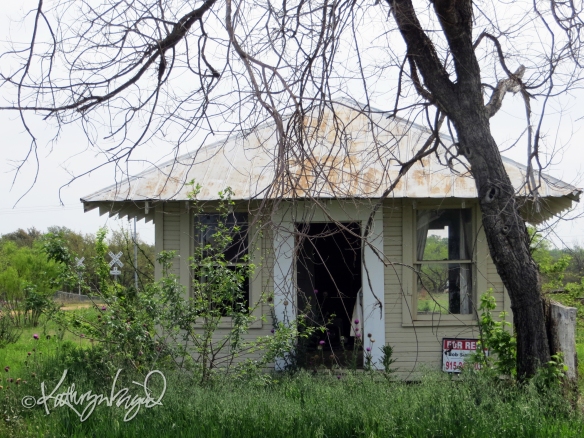
Lots of natural light, established yard, easy access to transportation (railroad across the street), air conditioning included.
I love a good ruin. While I understand the urgency of need for shelter among the homeless of the world and I generally don’t condone waste, the beauty of a derelict and decaying building speaks to me of history, mystery and longing. The reclamation of the ruin by nature, so astoundingly quick in geological terms, appears in the lifetime of a human to be perversely slow, creeping up and catching observers unawares. Deferred maintenance–a term that has taken on a modern oxymoronic twist I despise, given that such deferral is really deference to eventual wrack and ruin of a very irresponsible sort–becomes dire in what seems to have been the length of the watchman’s single circuit, and when we come back to the front door of the property we thought we’d only just circumambulated, it’s already hanging by one rusty hinge.
The character in and inherent fairytales posed by ancient ruins are naturally enhanced and perhaps exaggerated by their superior age, so a once-fine castle or cathedral, stone cottage or pillared temple has an advantage in terms of potential drama. But I am equally fond of a tumble-down shed or an industrial derelict, for nothing in its skeletal state lacks the piquant possibility of backstory as the mind attempts to re-flesh it with purpose and activity. Given half a chance, I might attempt to revive the corpse in the way that I went with cousins and undertook the rehabilitation of an abandoned cabin near our grandpa’s when we were young, because the romance of emptiness is that it’s always seemingly waiting for something special to happen. On the other hand, spending time in a ruin only to contemplate what did or might happen there can be just as alluring.
In this regard, I suppose I think of ruins as endlessly optimistic, though it may seem quite contradictory: the sense of their potential, whether for new life or for telling their stories of what has gone before, tends to outweigh the sense of sorrow that is in their current state of dishevelment and disrepute.
I wonder, then, how I so often forget to see imperfect looking people in the same way.


I understand what you mean about seeing the potential and the stories that could be told too Kathryn. I have a bit of a thing for urban decay and industrial wasteland…… so much history there in the remains.
Nothing quite like being amid ruins for making me believe in parallel universes: the sense of palpable history and potential is so strong!
I always tell Pete when we are in an old building or a derelict one that I can feel the history – wish I knew the stories each place has seen – can you just imagine!
Have a beautiful weekend Kath.
🙂 Mandy xoxo
Yes, as you can see by my comment to Claire above, I know exactly what you mean. Such secrets! Such mystery! Such hope!
It’s been too many weekends since you wrote this, I know, but generally they’ve been quite beautiful, not least of all because now they’re part of *my* history. 😉
Many hugs, Mandy! 🙂
xoxo!
Kath
Your last line is a good extrapolation.
Good, maybe; frustratingly true, definitely!
I agree with you, Kathryn, and these lines say it all, “the sense of their potential, whether for new life or for telling their stories of what has gone before, tends to outweigh the sense of sorrow that is in their current state of dishevelment and disrepute.” And then to end your post with such profoundness! Something for us all to ponder…xo
I’m in a little more of a ponderous pondering mood today, a bit melancholy and feeling my facade is crumbling slightly–and thinking that maybe I need to allow *myself* a little space for positive interpretation too. 😉
xoxo!